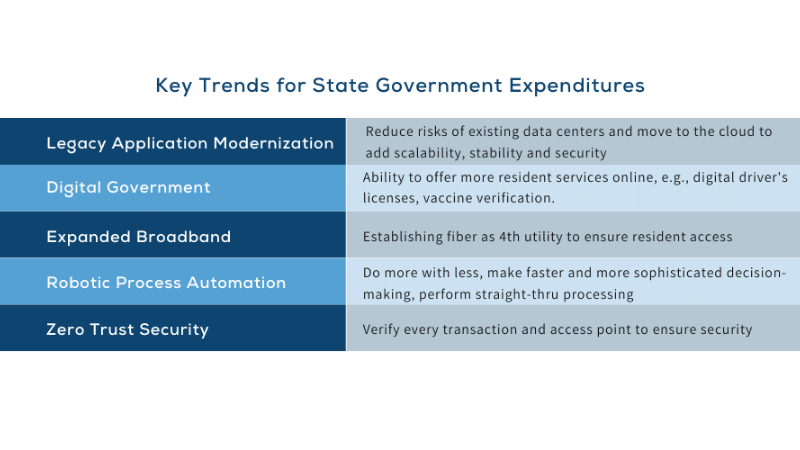How States can Create Better Resident Outcomes by using ARPA Funding for Technology Modernization
How States can Create Better Resident Outcomes by using ARPA Funding for Technology Modernization
In 2020, state CIOs nationwide considered modernizing legacy systems one of their top five priorities. With an unprecedented amount of funding now available through the American Rescue Plan Act (ARPA), it’s no surprise that many state leaders are evaluating how they can expand their modernization efforts. But if they want modernization to produce better resident outcomes, state leaders must be strategic – focusing on sustainable, scalable investments that meet real-world needs in their communities.

While modernization efforts will look different in every state, government leaders should focus on three key areas for fostering lasting change through modernization:
1. Creating More Frictionless Experiences for Residents
State governments must continue to create easy-to-use digital tools that allow residents and business owners to transact with government. Examples could include applications that let residents verify eligibility for cash assistance from their mobile device or “one stop” online portals where small business owners can interact with multiple agencies. By modernizing these services to be more aligned with the way many of us conduct our daily business, the government can distribute resources back to residents more quickly.
2. Strengthening Existing Systems with Predictive Capabilities
The volume of data collected by government has grown exponentially over the past several years, and we’re seeing an increased focus on leveraging that data for predictive analytics. Predictive analytics is a method of forecasting the likelihood of future outcomes based on historical data, current data, and various analytics techniques, including statistical algorithms and machine learning. For example, states can use predictive analytics to prepare for changes in population that will affect school districting or guide their highway development plans based on anticipated changes in traffic volume.
Predictive analytics is particularly valuable when applied to community health. For instance, states could compare analyze waiting room capacity, physician employment numbers, and hospital bed inventory across regions to identify areas at high risk of overcrowding if faced with a new COVID variant or if social distancing requirements are made more stringent.
3. Invest in Edgeless Infrastructure
Modernization can only go so far without the underlying infrastructure that allows connectivity anywhere and everywhere. States must invest in improved broadband access, fiber, GIS, 5G and mobile support. These investments are not only important for resident access to government services, education, and healthcare, but they also position states to be better prepared for disruptive events like COVID outbreaks or weather emergencies.
Getting started
Even though ARPA gives states access to a great deal of funding, state leaders must be strategic about how and when to use those funds. To put it simply – you can’t do everything all at once and must be aware of the risks and dependencies within your current portfolio of IT assets. A Modernization Roadmap can provide important detail in how to best prioritize and sequence initiatives. A well-executed modernization roadmap helps teams understand how to achieve incremental benefits and resident outcomes while ensuring continuity of operations and mitigation of risks. The roadmap is a critical for aligning IT and business decision makers aligned on the next steps for a modernized application portfolio.

